Contemporary Social Problems Exam
1/107
Earn XP
Description and Tags
Name | Mastery | Learn | Test | Matching | Spaced |
|---|
No study sessions yet.
108 Terms
Functionalist
According to the ___________________ perspective society is a system of interconnected parts. Each part contributes to the smooth efficiency of a society as a whole.
Conflict
According to the ___________________ perspective society is made up of different groups who compete for power and resources within their society.
Interactionist
According to the ___________________ perspective the examination of social interaction through everyday behavior in order to generalize to society as a whole.
Feminist
According to the ___________________ perspective the issue of inequality and equality for both men and women is fundamental for a strong functioning egalitarian society.
Five Traditional Institutions
Family
Education
Economic
Religion
Political
Media/technology
Criminal justice
Healthcare
Name some social institutions (systems) with a social structure in Canadian society.
The belief that there are innate psychological, behavioural, or intellectual differences between females and males and that these differences connote the superiority of one group and the inferiority of another
What is ‘sexism’?
The social definitions and expectations associated with being male or female
What is ‘gender’?
A person’s biological classification as male or female.
What is ‘sex’?
Also known as “institutional sexism”
Refers to the ways in which the organization of society subordinates individuals and groups based on their sex classification
Has resulted in gender differences in educational attainment, income levels, and occupational and political involvement
What is ‘structural sexism’?
Work performed by women is socially defined as less valuable than work performed by men
Work requires significant amount of “emotional labour”
What is the ‘devaluation hypothesis’?
Female—male pay differences are a function of differences in education and skill levels, training and work experience
What is the ‘human capital hypothesis’?
Tasks and jobs that are distinct but have equivalent value and utility in the workplace and economy
What is ‘comparable worth’?
The concentration of women in certain occupations and of men in other occupations.
What is ‘occupational sex segregation’?
Jobs that offer few benefits, often have low prestige, and are disproportionately held by women.
What are ‘pink collar jobs’?
An invisible, socially created barrier that prevents women and other minorities from being promoted into top corporate positions.
What is the ‘glass ceiling’?
The ways in which the culture of society perpetuates the subordination of individuals based on their sex classification.
What is ‘cultural sexism’?
The recent tendency for definitions of masculinity and femininity to become less clear, resulting in individual exploration of the gender continuum.
Ex: Women in the military, playing pro basketball, running corporations and governing
What is ‘gender tourism’?
Woman learn to put family ahead of their education and careers
Women are more likely than men to live below the poverty line
What is the ‘feminization of poverty’?
The belief that women and men should have equal rights and responsibilities.
What is ‘feminism’?
As a consequence of the women’s rights movement, men began to re-evaluate their own gender status.
Michael Schwalbe examined the men’s movement as both a participant and a researcher, by attending meetings and commencing interviews with active members for three years. His research indicates that participants, in general, are white middle-class men who feel they have little emotional support, responsibilities, unsatisfactory careers, and what is percieved as an overly competitive society.
What is the ‘men’s movement’?
Behavior characterized by the making of unwelcome and inappropriate sexual remarks or physical advances in a workplace or other professional or social situation (Oxford Languages).
There are two types of sexual harassment featured in the textbook that specifically focus on the workplace:
Quid pro quo: an employer requires sexual favours in exchange for a promotion, salary increase, or any other employee benefit.
The existence of a hostile environment that unreasonably interferes with job performance, as in the case of sexually explicit comments or insults being made to the employee.
What is ‘sexual harassment’?
An attempt to ensure that there is a proportional number of designated target groups (e.g., women, visible minorities, Aboriginal peoples, and people with disabilities) throughout all income and occupational levels at ratios that are consistent with the proportion of these groups within the local or regional workforce.
What is ‘employment equity’?
A category of people who are believed to share distinct physical characteristics that are deemed socially significant
What is ‘race’?
A shared cultural heritage or national origin.
What are ‘ethnicities’?
The genes of black and white North Americans are likely 99.9% alike. This denotes that race is not actually a genetic difference, but a social construct.
How similar or different are the genes of black and white peoples?
The word that scientists who reject the race concept now use when referring to groups that most people would call races.
What are ‘populations’?
Genocide
Expulsion
Slavery
Colonialism
Segregation
Acculturation
Assimilation (primary and secondary)
Amalgamation
What are some (8) patterns of racial and ethnic group interaction?
The systematic annihilation of one racial or ethnic group by another.
What is ‘genocide’?
Also known as “population transfer”
When a dominant group forces a subordinate group to leave the country or to live only in designated areas of the country.
What is ‘expulsion’?
A condition in which one social group treats another group as property to exploit for financial gain.
What is ‘slavery’?
When a racial or ethnic group from one society takes over and dominates the racial or ethnic group(s) of another society.
What is ‘colonialism’?
The physical and social separation of categories of individuals, such as racial or ethnic groups.
What is ‘segregation’?
de jure segregation: segregation that is required by law (de jure translates to “law” in Latin)
de facto segregation: segregation that is not required by law, but exists “in fact”, often as a result of housing and socioeconomic patterns (de facto translates to “in fact” in Latin)
What are the two types of segregation?
Learning the culture of a group different from the one in which a person was originally raised.
What is ‘acculturation’?
The process by which minority groups gradually adopt the cultural patterns of the dominant majority group.
What is ‘assimilation’?
secondary assimilation: the integration of different groups in public areas and in social institutions, such as the government, neighbourhoods, schools and the workplace
primary assimilation: the integration of different groups in personal, intimate associations such as friends, family and spouses
What are the two types of assimilation?
Also known as “marital assimilation”, which is defined as assimilation that occurs when different ethnic or racial groups become married or pair-bonded and produce children.
The physical blending of different racial or ethnic groups, resulting in a new and distinct genetic and cultural population; results from the intermarriage of racial and ethnic groups over generations.
What is ‘amalgamation’?
The social norm that influences people to marry within their social group and discourages interracial and interethnic marriages.
What is ‘endogamy’?
A state in which racial or ethnic groups maintain their distinctness, but respect each other and have equal access to social resources.
What is ‘pluralism’?
A philosophy that argues that the culture of a society should represent and embrace all racial and ethnic groups in that society.
What is ‘multiculturalism’?
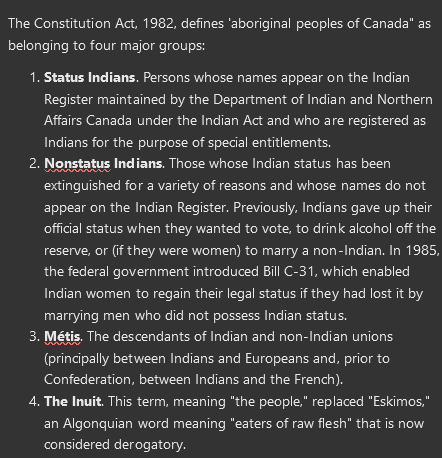
The Constitution Act, 1982, defines 'aboriginal peoples of Canada" as belonging to four major groups:
Status Indians. Persons whose names appear on the Indian Register maintained by the Department of Indian and Northern Affairs Canada under the Indian Act and who are registered as Indians for the purpose of special entitlements.
Nonstatus Indians. Those whose Indian status has been extinguished for a variety of reasons and whose names do not appear on the Indian Register. Previously, Indians gave up their official status when they wanted to vote, to drink alcohol off the reserve, or (if they were women) to marry a non-Indian. In 1985, the federal government introduced Bill C-31, which enabled Indian women to regain their legal status if they had lost it by marrying men who did not possess Indian status.
Métis. The descendants of Indian and non-Indian unions (principally between Indians and Europeans and, prior to Confederation, between Indians and the French).
The Inuit. This term, meaning "the people," replaced "Eskimos," an Algonquian word meaning "eaters of raw flesh" that is now considered derogatory.
What is ‘aboriginality’?
The Constitution Act, 1982 contains the Canadian Charter of Rights and Freedoms and other provisions, including the rights of Indigenous peoples and the procedures for amending the Constitution of Canada. (laws.justice.gc.ca)
The Constitution Act, 1982 is a landmark document in Canadian history. It achieved full independence for Canada by allowing the country to change its Constitution without approval from Britain. It also enshrined the Charter of Rights and Freedoms in Canada's Constitution, the highest law of the land. (The Canadian Encyclopedia)
What is the Constitution Act of 1982?
Oversimplified or exaggerated generalizations about a category of individuals. Stereotypes are either untrue or are gross distortions of reality.
What are ‘stereotypes’?
An attitude or judgement, usually negative, about an entire category of people based on their group membership.
What is ‘prejudice’?
The belief that certain groups of people are innately inferior to other groups of people based on their racial classification. Racism serves to justify discrimination against groups that are perceived as inferior.
What is ‘racism’?
A subtle, often unintentional form of prejudice exhibited by many well-intentioned people who possess strong egalitarian values and who themselves as non-prejudiced.
Negative feelings of discomfort, uneasiness, disgust, and sometimes fear towards minority groups.
What is ‘aversive racism’?
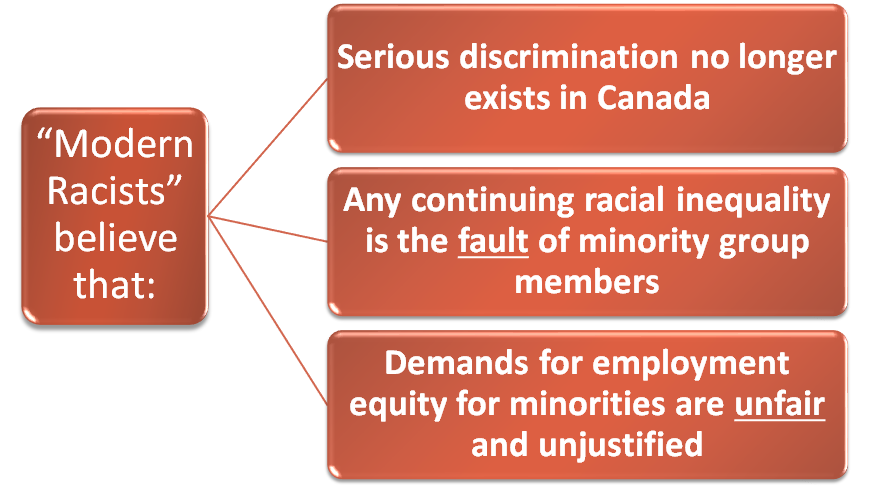
A subtle and complex form of racism in which individuals are not explicitly racist, but tend to hold negative views of racial minorities and blame them for their social disadvantages.
What is ‘modern racism’?
A psychological theory of prejudice that suggests prejudice arises in people with a certain personality type. According to this theory, people with an authoritarian personality, who are highly conformist, intolerant, cynical and preoccupied with power, are prone to prejudice.
What is ‘authoritarian-personality racism’?
Acts of violence motivated by prejudice.
What are ‘hate crimes’?
Occurs when normal operations and procedures of social institutions result in unequal treatment of minorities.
Is covert and insidious and maintains the subordinate position of minorities in society.
Majority group members make rules that favour their own group.
What is ‘institutional discrimination’?
The practice, usually if not exclusively carried out in law enforcement or border crossing, that subjects some groups to increased surveillance or scrutiny based on racial or ethnic factors rather than any specific reason for suspicion.
What is ‘racial profiling’?
Differential treatment of individuals based on their group membership.
What is ‘discrimination’?
Individual discrimination: occurs when individuals treat persons unfairly or unequally because of their group membership.
Overt discrimination: the individual discriminates because of his or her own prejudicial attitudes.
e.g., not rent to a minority family because the landlord is prejudiced against them.
Adaptive discrimination: based on the prejudice of others.
e.g., not rent to a minority family because the landlord is afraid other renters who are prejudiced may move out of the neighbourhood.
What is individual discrimination, and what are two subtypes?
Subtle verbal and non-verbal slights based on group membership.
They are ubiquitous in the lives of Black/Indigenous/People of Colour, women, and 2SLGBTQ+ individuals.
Microaggressions are such commonplace, casual occurrences in everyday interpersonal exchanges and environmental messages that they are frequently overlooked or perceived by recipients as not worth confronting
Perpetrators are often unaware that they said or done something hurtful.
When the concepts of microaggressions are discussed only then do people tend to readily recognize common specific microaggressive acts, and the reality of racial discrimination
Discussing and identifying microaggressions leads to a deep understanding of how institutional discrimination is perpetuated and can provide a powerful tool for combatting discrimination.
What is a ‘microaggression’?
Microassaults: A microassault occurs when a person intentionally behaves in a discriminatory way while not intending to be offensive. An example of a microassault is a person telling a racist joke then saying, “I was just joking.”
Microinsults: A microinsult is a comment or action that is unintentionally discriminatory. For example, this could be a person saying to a student from a disadvantaged community, “Your people must be so proud that you’re in college.”
Microinvalidations: A microinvalidation occurs when a person’s comment invalidates or undermines the experiences of a certain group of people. An example of a microinvalidation would be a settler telling an Indigenous student “I know there used to be a lot of issues, but anti-Indigenous racism isn’t that big a deal anymore.”
What are three types of microaggressions?
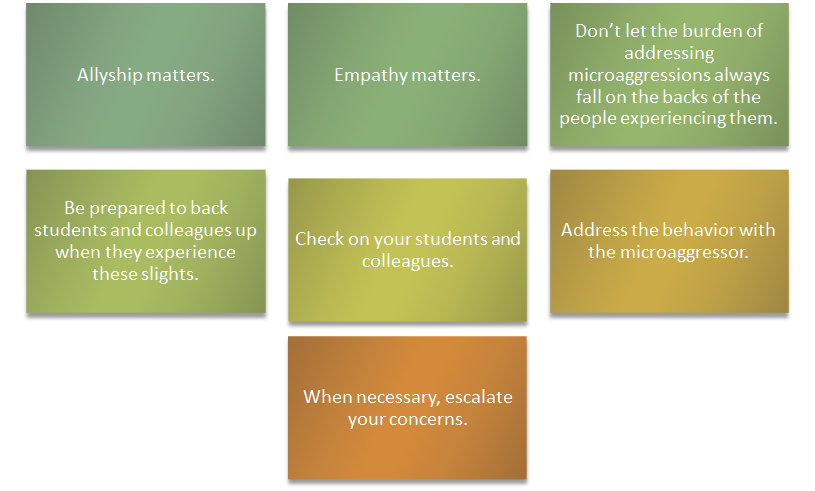
Pick your battles. Microaggressions occur frequently and for self-care and security, consider if the subtle act of exclusion warrants action.
Consider where and when you choose to address the offender. When called out, perpetrators/initiators often respond with defensiveness, minimization, or blaming that can cause further harm. To minimize additional harm, consider if intervention should be in public or private; in the moment or at a later time.
Adjust your response as the situation warrants. Does the situation require education or confrontation? Consider a collaborative tone/approach to lower defensiveness.
Be aware of relationship factors and dynamics with perpetrators. The relationship between subject and initiator influences how to respond. Education may be more of a priority for a colleague or student than for a stranger.
Always consider the consequences of intervention, especially when a strong power differential exists between initiator and subject. Intervention can lead to putting the target, observer/ally at additional risk or negative outcomes.
How do we intervene and address microaggressions?
Traditionally defined as the lack of resources necessary for material well-being
What is ‘poverty’?
Absolute poverty: chronic absence of the basic necessities of life
Relative poverty: deficiency in material and economic resources compared with some other population
What is ‘absolute poverty’ and ‘relative poverty’?
A composite measure of poverty based on three measures of deprivation:
(1) deprivation of life, which is measured by the percentage of people expected to die before age 40;
(2) deprivation of knowledge, which is measured by the percentage of adults who are illiterate; and
(3) deprivation in living standards, which is measured as a composite of three variables--the percentage of people without access to health services, the percentage of people without access to safe water, and the percentage of malnourished children under five.
What is the ‘human poverty index’?
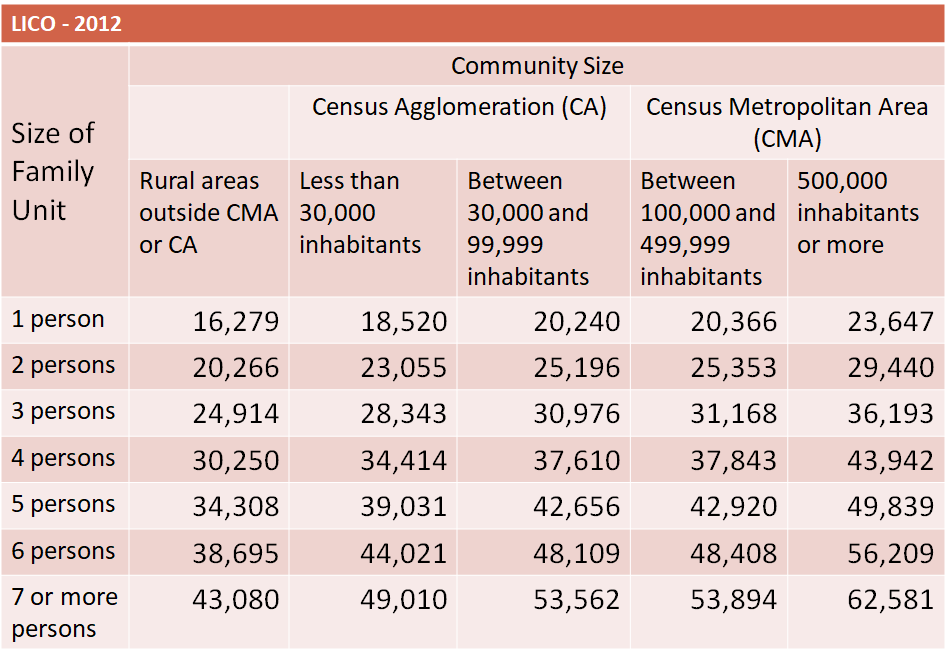
Developed by Statistics Canada as a measure of poverty. Estimating that poor families or individuals spend approximately 34.7 percent or more of their pre-tax income on such basic needs as food, shelter, and clothing, 20 percentage points were added to this figure to determine the cut-off This standard suggests that individuals or families who spent 54.7 percent of their pre-tax income on food, clothing, and shelter would experience financial difficulty. Different low income cut-off lines are established by Statistics Canada for different communities as well as for families of varying sizes within these communities.
What is the ‘low income cutoff’?
Proletariat: Workers who were often exploited by the bourgeoisie
Bourgeoisie: The owners of the means of production
What is the ‘proletariat’ and the ‘bourgeoisie’?
A persistently poor and socially disadvantaged group that disproportionately experiences joblessness, welfare dependency, involvement in criminal activity, dysfunctional families, and low educational attachment.
What is the ‘underclass’?
The set of norms, values and beliefs and self-concepts that contribute to the persistence of poverty among the underclass.
What is ‘culture of poverty’?
Total assets of an individual or household
-
Liabilities (mortgages, loans, and debts)
=
Wealth
The value of a home
Investment real estate
Cars
An unincorporated business
Life insurance (cash value)
Stocks, bonds, mutual funds, and trusts
Chequing and savings accounts
Retirement savings plans
Valuable collectibles
What is ‘wealth’?
Individuals who work in the labour force, but live in poverty
Many single parents
What is the ‘working poor’?
Poverty that is transmitted from one generation to the next
Mead (1992) – may be caused by welfare dependency
Wilson (1987: 1996) – a variety of social factors (decline in well-paid jobs, migration of middle class to suburbs, impact of deteriorating neighbourhoods on children and youth…)
What is ‘intergenerational poverty’?
Also known as “equal pay for work equal of value”
Requires equal pay for women who perform jobs of equal value to men in the same establishment. Employers are required to compare women’s and men’s jobs on the basis of skill, effort, responsibility, and working conditions to determine their value.
What is ‘pay equity’?
The skills, knowledge and capabilities of the individual
What is ‘human capital’?
Canada’s first universal welfare program, introduced in 1945, which promised a monthly allowance paid to families with children. The term universal here refers to the fact that the benefit flowed from the principle of entitlement and was available without reference to a recipient’s income or assets.
What is ‘family allowance’?
The state of having no home. (Oxford Languages)
What is ‘homelessness’?
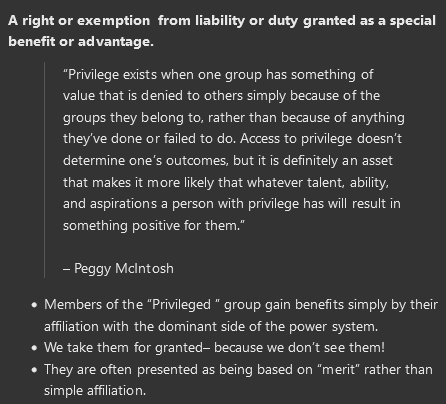
A right or exemption from liability or duty granted as a special benefit or advantage.
“Privilege exists when one group has something of value that is denied to others simply because of the groups they belong to, rather than because of anything they’ve done or failed to do. Access to privilege doesn’t determine one’s outcomes, but it is definitely an asset that makes it more likely that whatever talent, ability, and aspirations a person with privilege has will result in something positive for them.”
– Peggy McIntosh
Members of the “Privileged ” group gain benefits simply by their affiliation with the dominant side of the power system.
We take them for granted– because we don’t see them!
They are often presented as being based on “merit” rather than simple affiliation.
What is ‘privilege’?
Feel at home in the world
Escape dangers that others may suffer
Choose whether or not to address certain issues of oppression or injustice
Not have to hide parts of our identity or lifestyle
What does privilege allow us to do?
An academic term that capture the all-encompassing dimensions of White privilege, dominance, and assumed superiority in society
These dimension include:
Ideology
Institutional
Social
Cultural
Historical
Political
Interpersonal
What is ‘whiteness’?
1987
Today it is made up of provincial associations (OFBA founded in 1992) with 700 local food banks and 3000 food programs throughout Canada.
What year was the Canadian Association of Food Banks (CAFB) founded?
120 registered member food banks
Unknown # of non-registered
How many registered and non-registered member food banks are there in Ontario?
300,000 in Ontario
Over 800,000 in all of Canada
How many people are being serviced by food banks in Ontario, and in all of Canada?
Over 860,000
How many Canadians use a food bank each month?
1 in 6 people
How many people assisted by food banks are employed?
1 in 4 households
How many households pay more than it can afford for housing?
34%
What percentage of food bank users are children and youth?
66%
What percentage of food bank users pay market-level rent?
20%
What percentage of food bank users live in social housing?
8% own homes
6% are homeless
What percentage of food bank users own homes, versus how many are homeless?
They have a goal or vision they hope to achieve
Anything would be better than the “painful” situation they’re in
An educator or spouse/friend or mentor (coach) who shows/helps them live differently
A specific talent or ability that provides them an opportunity
What are four major reasons that individuals leave poverty?
Understand your privilege
Listen and do your homework(so you can get caught up on the issues
Speak up and not over, Use your voice to educate others
Realise you'll make mistakes and apologise when you do.
Ally is a verb, do the work
What are the five tips to being an ally?
A theory claiming that the elderly disengage from productive social roles to relinquish these roles to younger members of society. As this process continues, each new group moves up and replaces another, which, according to disengagement theory, benefits society and all of its members.
What is ‘Disengagement Theory’?
Fear or dread of the elderly.
What is ‘Gerontophobia’?
The ability of those who live facing persistent stigma to cope more easily with adverse social situations than those who have not previously encountered much prejudice.
What is ‘Crisis Competence’?
True
True or False: Poverty is caused by a cycle of poor and uneducated parents.
True
True or False: 1/3 of children in Canada are overweight or living with obesity
True
True or False: The government sees children as a social problem and favours parental rights against children’s rights
The belief that age is associated with certain psychological, behavioural, or intellectual traits.
What is ‘ageism’?
A theory claiming that as society becomes more technologically advanced, the position of the elderly declines.
What is ‘Modernization Theory’?
The generation that has the responsibility of simultaneously caring for their children and their aging parents.
What is a ‘sandwich generation’?
Show how the ages of a community are distributed visually.
What is an ‘age pyramid’?
True
True or False: The age distribution in different parts of Canada is different because of things like fertility rates, migration trends, and the way the economy works.
Increased consumer spending on weddings and related industries
Expanding the market for businesses targeting LGBTQ+ community
What was the economic impact of same-sex marriage?
Affirmed the principle of equality before the law, extending the same legal rights and responsibilities to same-sex couples as enjoyed by heterosexual couples.
What were the legal implications of equality by legalizing same-sex marriage?
Exceeds harm inflicted on individuals; goals are to intimidate and/or injure an entire community
What is ‘disproportionate harm’?
True
True or False: Conversion therapy isn’t always a paid profession, and has had a negative impact on the quality of life for the LGBTQ+ community, as well as negatively impacted the economy.